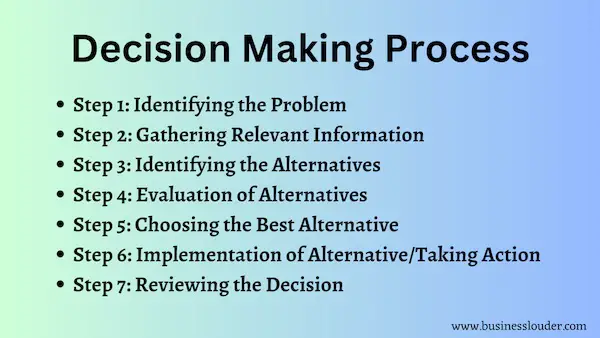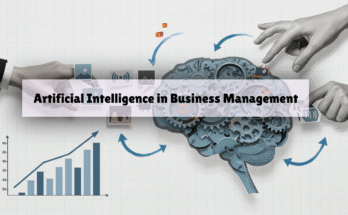Did you know that an average adult makes approximately 35,000 decisions per day? What’s even more surprising is the fact that 87% of them admit to changing their minds about it later on!
Decision-making is one of the most significant aspects of our everyday lives, even for a business management. The decision made today, by the manager, decides how the future of the organization will be in the upcoming years.
The Decision Making Process of business is a highly effective method to make informed, thought-out decisions, which helps in achieving business goals. So here in this blog post we have explain decision making process in management and 7 steps in decision making process.
What is the Decision Making Process in Management?
The Decision Making Process in management includes a series of steps for achieving specific business goals and objectives. The manager selects the most feasible course of action out of the available alternatives. It is the responsibility of the manager and leaders to make an effective decision and implement it in the best ways possible for the prosperity of the business organization.
Effective and successful decisions will result in profits for the firm, contrarily ineffective and unsuccessful decisions will result in losses.
7 Steps in Decision Making Process

The decision-making process in management is a step-by-step process that provides an opportunity to review whether the decision was the right one. Given below are the 7 important steps in decision making process.
1. Identifying the Problem
The first important step of the decision-making process is to identify the main problem that needs to be resolved. Problems may arise due to internal or external factors of an organization.
The manager needs to monitor the working environment, symptoms of the problem, and root cause analysis of the problem. For this, he/she has to consider a progress report from subordinates. The report should be compared with the actual performance and factors affecting regular work should be analyzed. Besides, he/she should also use skills, knowledge, experience, and judgment to conclude.
2. Gathering Relevant Information
Once the problem is identified, it’s time to gather information relevant to that problem. Conducting an internal assessment to find out where the organization has succeeded and failed is a helpful way. It is also helpful to seek information from external sources, including studies, market research, and even evaluation from paid consultants.
3. Identifying the Alternatives
A problem may have various solutions. The decision-maker should be creative and innovative in identifying and studying all the possible alternative solutions. He/She can identify alternatives from various sources like discussions with subordinates, records and files of problems, opinions and views of experts, creditors, customers, etc.
It is the manager’s duty to develop and find those alternatives, which are strategic to the problems. The framing of alternative solutions is mental as well as creative work that requires discussion and creativity.
4. Evaluation of Alternatives
In this step, every alternative is evaluated and studied with regard to the decision-making process.
The following queries are usually taken into consideration while evaluating any alternative solution – first, whether the alternative solution is feasible in terms of time, costs, human and other resources, second, whether the alternative solution is satisfactory for solving problems, third, whether the consequences of the alternative is favorable to the organization.
Considering these factors help select a course of action.
5. Choosing the Best Alternative
This is the part of the decision-making process where the actual decision needs to be made. For the best and feasible alternative, managers should consider short-term as well as long-term impacts on organizational performance.
6. Implementation of Alternative/Taking Action
Here comes the operational part of the decision-making process. In this step, the decision-maker needs to provide instructions to the operational authorities and also communicate with them from time to time.
The manager has to delegate authority to the subordinates based on weightage of responsibility. Management also has to take into consideration the organizational objectives that can be achieved if the course of action is implemented in the best way possible.
7. Reviewing the Decision
As decision-making is a continuous process it is required to evaluate the performance from time to time. A follow-up and review of the decision taken and its achievements are essential.
In case the implementation of a particular decision does not give desired results, it is necessary to modify the procedures and techniques to bring the work to the desired track. Ask the questions – Is the main problem solved?Is the question answered? Are the goals and objectives met?
If the answer to these questions are positive, take note of what all worked, for future reference. If it’s negative, learn from the mistakes and begin the decision-making process again.
Stages of Decision Making Process
According to Leonard Schlesinger, who is a Harvard Business School Professor, most managers view decision-making as a single event, when it is actually an entire process. This can eventually lead to managers overestimating their abilities to influence outcomes. This might also close them off from alternative perspectives and diverse ways of thinking.
There are a few stages in the decision making process that can be employed so that the manager can have a greater influence in their organization.
- Framing Decisions
- Structuring a Team
- Considering the Time Frame
- Establishing an Approach
- Encouraging Discussion and Debate
- Navigating Group Dynamics
- Ensuring everything is in Place for Implementation
- Achieving Closure and Alignment
The Closing Lines
Decision making is definitely not an easy task, but it is one of the most important basic management skills for every individual. It is a cognitive ability and can differ from person to person. Making decisions which are timely and based on careful analysis of various information is critical for success. Decisions should neither be taken in haste nor should be procrastinated indefinitely.
Well-thought and timely decision making is extremely important for the success of any business in today’s time, and a logical approach must be taken for that.
Now we hope you have understood the steps in the decision making process. If you still have any questions regarding this guide please let us know in the comment section below, it will definitely help you.




3 Comments on “Top 7 Important Steps in Decision Making Process”